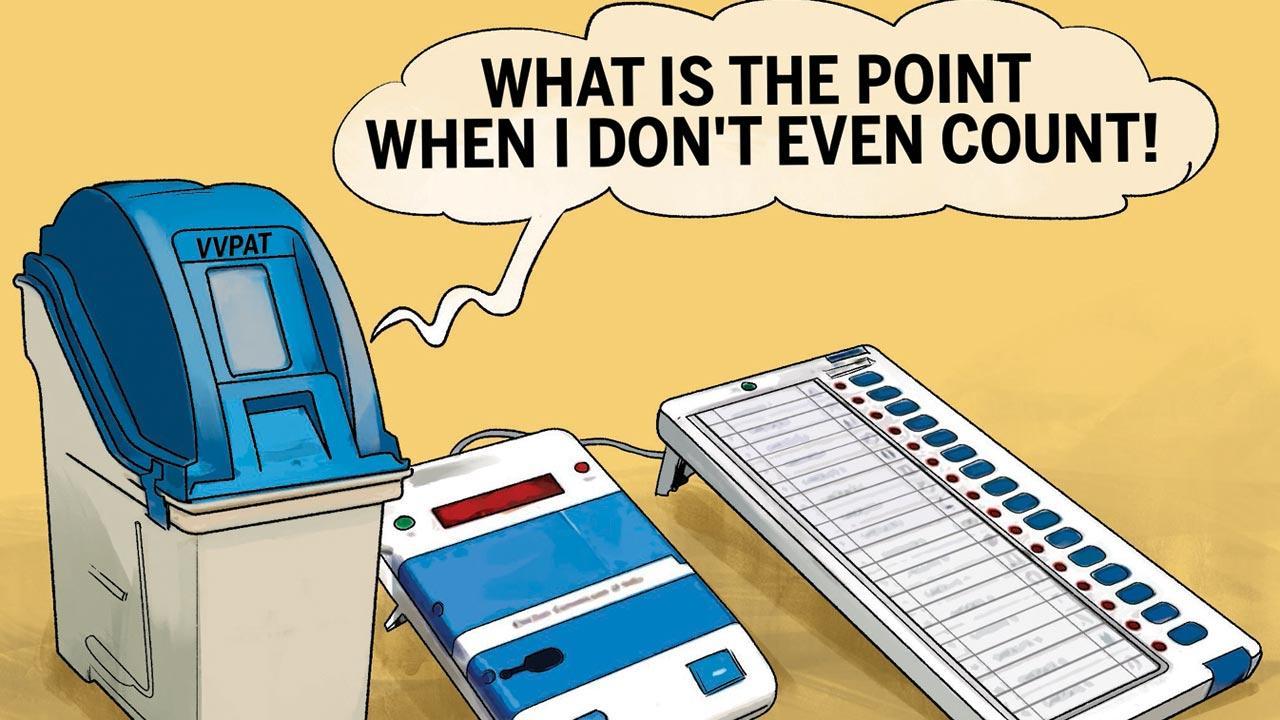One sure way of addressing the disquiet over the EVM is to count VVPAT slips in each constituency until the winner can be announced with high confidence

The electronic voting machine does bewilder, mimicking, at times, the computing skills of a Class I student. Illustration/Uday Mohite
 Congress leaders Kamal Nath and Digvijaya Singh have ascribed their party’s defeat in Madhya Pradesh to the Electronic Voting Machine (EVM), bolstering persistent doubts over its efficacy. They are not alone in doing so: leaders from L K Advani to Mayawati, Akhilesh Yadav to Arvind Kejriwal have confessed to the EVM being their bugbear—but alas, only after being beaten black and blue in the elections.
Congress leaders Kamal Nath and Digvijaya Singh have ascribed their party’s defeat in Madhya Pradesh to the Electronic Voting Machine (EVM), bolstering persistent doubts over its efficacy. They are not alone in doing so: leaders from L K Advani to Mayawati, Akhilesh Yadav to Arvind Kejriwal have confessed to the EVM being their bugbear—but alas, only after being beaten black and blue in the elections.
ADVERTISEMENT
Today, express doubts about the EVM to a BJP leader and s/he will likely say, “You hate Narendra Modi.” The victorious think the EVM can do no wrong.
The EVM does bewilder, though, mimicking, at times, the computing skills of a Class I student. In the 2019 Lok Sabha elections, when EVMs were deployed across India, as many as 373 constituencies reported a mismatch between the votes polled and votes counted. The highest mismatch was of 18,331 votes. Not only did the Election Commission of India (ECI) refuse to respond to queries about the discrepancies, it removed the election data from its website.
The ECI’s conduct prompted the Citizens’ Commission on Elections (CCE), under former Supreme Court judge Madan Lokur, to prepare a report on EVMs and VVPAT, or Voter Verifiable Paper Audit Trail, in 2020. The report was written by Subhashis Banerjee, then professor of computer science at the Indian Institute of Technology, Delhi, with inputs from other Commission members. After reading the CCE report, I spoke to Banerjee. Here is a summary of our discussion.
An EVM is considered secure when it allows the voter to cast his/her vote as s/he intended; when the vote is registered as s/he cast; and when the vote is counted as registered. Thus, you may intend to vote for X and press the button on the ballot unit with X’s symbol but the vote could get cast for Y. Then, you may have succeeded casting your vote for X but it could get registered for Y. Or your vote may be registered for X but get added to Y’s tally.
There is no guarantee against manipulation taking place at any of the three steps. American computer scientist Rebecca Mercuri, in 1992, argued theoretically that no EVM can ever be proved to be hack-proof. She suggested attaching a VVPAT and cross-checking the EVM count with the VVPAT count as one way of verifying that the EVM is functioning as intended.
The EVM-VVPAT system was introduced, in 2019, in all constituencies in India. The possibility of rigging cannot be ruled out, not just by changing the hard disk of the EVM-VVPAT’s control unit, as the Aam Aadmi Party famously demonstrated in 2017—it is, in fact, too cumbersome a process to go undetected. The possibilities of “side-channel” hacking also exist, that is, using ultrasound, electromagnetic waves, etc., to alter, say, the votes registered for X to be counted for Y. Or it could be used to stuff votes for Y even though these were not polled.
Could this explain the discrepancy between the votes polled and votes counted in 2019? Well! Even major international CPU manufacturers have struggled to design products impenetrable by side-channel hacking.
Doubts over the EVM persist also because the ECI refuses to publicly disclose the “source code”, or a set of instructions written in a computer language ordering the electronic machine to function in sync with actions carried out, as, for instance, casting and registering the vote for X when you pressed the button with his/her election symbol. Ideally, the ECI should have disclosed the source code and asked the public to detect loopholes for plugging them.
The ECI’s reluctance resembles that of examiners who are wary of showing examination papers they have graded to students, lest their mistakes are detected.
There are suggestions to return to the system of stamping the ballot paper and dropping it into the ballot box. Here you are sure your vote has been cast as intended. But you cannot be sure it would be counted as cast, for ballot boxes can be substituted, stuffed or looted. Papers also mean chopping wood, a no-no in these days of alarm over global warming.
Banerjee says the system of EVM-VVPAT is superior to that of the pure paper ballots, for the former provides for two-track verification.
Take the EVM tally and match it with the number of VVPAT slips. Not just VVPAT slips of five EVMs in every Assembly constituency, as is done in India, but of a statistically significant number.
The only way to address the disquiet over the EVM is to count all VVPAT slips in each constituency, Banerjee suggests, until it becomes possible to declare the correct winner with high confidence. The exact number of slips required to be counted will depend on the winning margin. The absolutely certain way of ascertaining the winner is this—if the EVM count for X were to show s/he has won by 500 votes, then count VVPAT slips until 499 of those are left, ruling out his/her defeat. This is an established process, called Risk-Limiting Audit. Such a system means you cannot have the thrill of knowing the results on the day of the counting. Rephrase that profound warning to read: Speed thrills but can kill democracy.
The writer is a senior journalist
Send your feedback to mailbag@mid-day.com
The views expressed in this column are the individual’s and don’t represent those of the paper
 Subscribe today by clicking the link and stay updated with the latest news!" Click here!
Subscribe today by clicking the link and stay updated with the latest news!" Click here!







